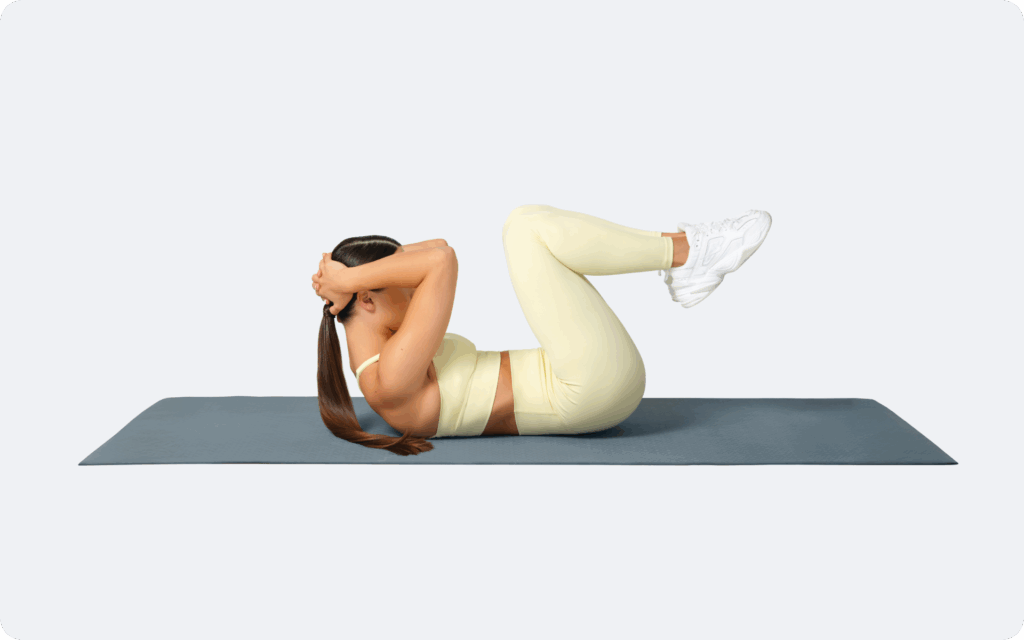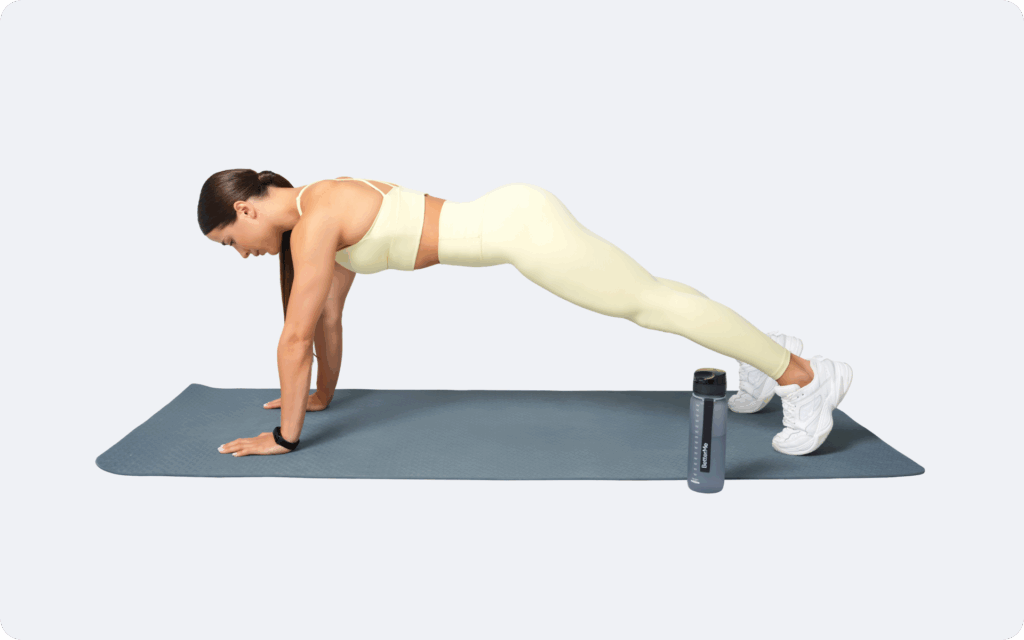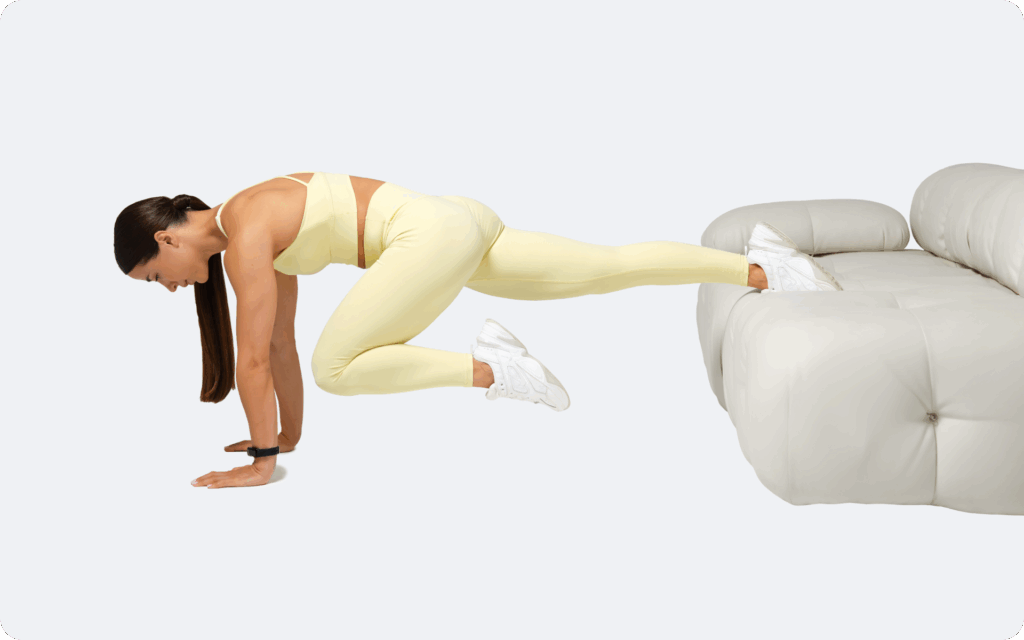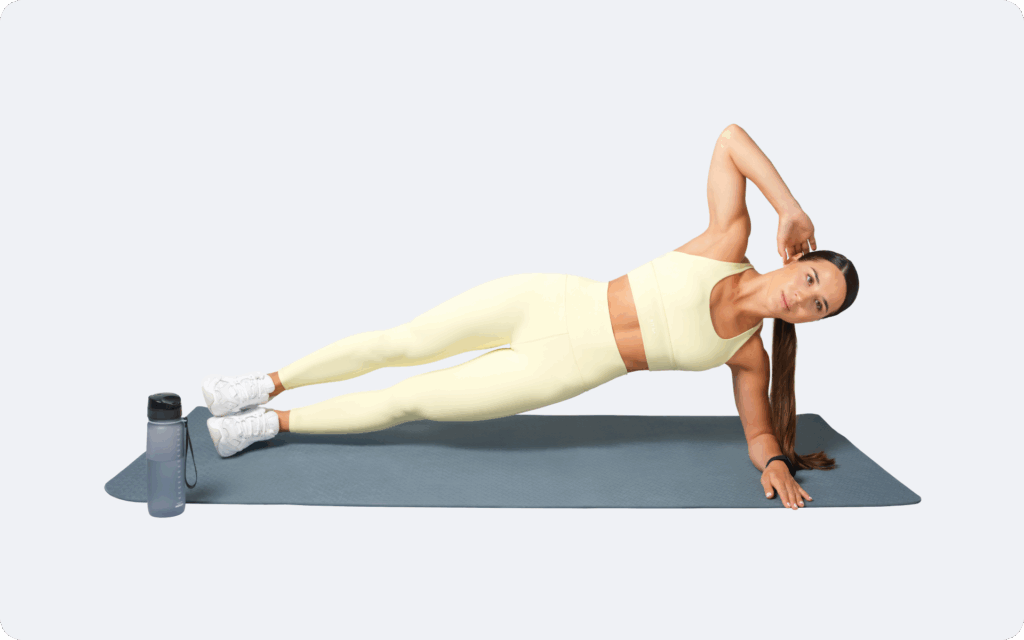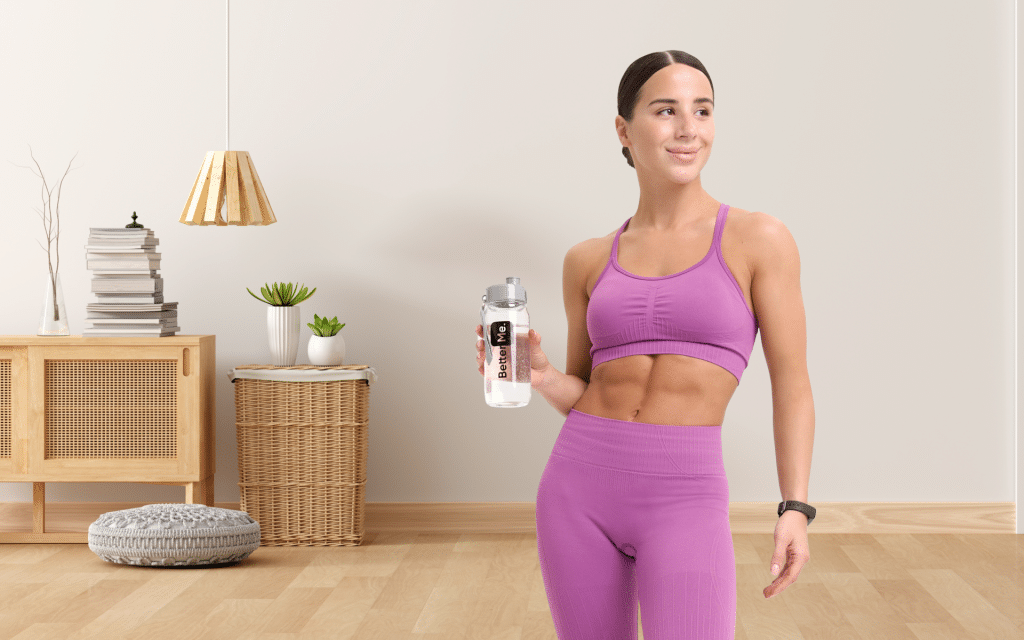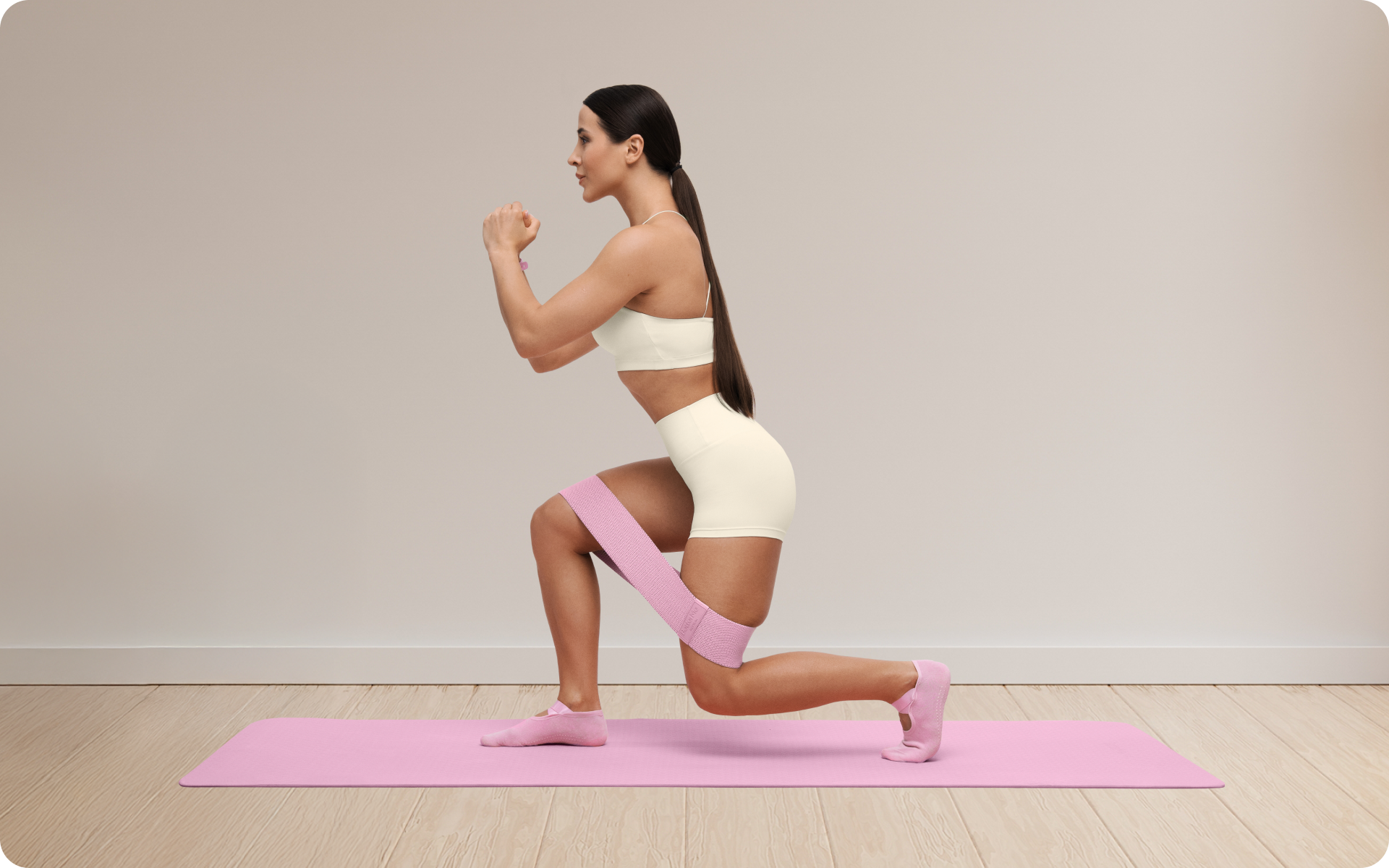Your core is more than a vanity muscle. It stabilizes your spine during heavy lifts, protects your lower back from injury, and transfers power between your upper and lower body during athletic movements. Whether you’re chasing visible abs or bulletproof core strength, the principles remain the same: consistent training, progressive overload, and smart programming.
This 8-week at-home ab workout plan delivers both. You’ll train twice per week using just five exercises, targeting all regions of your core musculature. No gym required – just commitment, space on your floor, and a willingness to work.
What Is a Workout Plan for Abs?
An effective ab workout plan systematically targets the muscles of your core: the rectus abdominis (your “six-pack” muscle), internal and external obliques (side abs), and transverse abdominis (deep core stabilizer).
To build these muscles, you need to understand muscle hypertrophy – the process by which muscle fibers grow in response to mechanical tension, metabolic stress, and muscle damage (1).
Abdominal hypertrophy follows the same principles as any other muscle group. Research has shown that three primary mechanisms drive muscle growth (2):
- Mechanical Tension: Created when you contract your abs against resistance, whether that’s a weighted crunch or holding a plank position.
- Metabolic Stress: The “burn” you feel during high-rep sets or timed circuits signals the accumulation of metabolites that trigger growth signals.
- Muscle Damage: Controlled damage to muscle fibers during training initiates repair processes that build them back stronger.
A workout plan for abs will likely follow these principles:
Exercise Frequency: Training abs 2-3 times per week provides optimal stimulus for growth while allowing adequate recovery (3). This program uses twice-weekly sessions spaced 72 hours apart.
Training Volume: Total sets per week matter more than single-session volume. Research has suggested that 10-20 sets per muscle group per week optimizes hypertrophy (4). This program delivers 15 sets across two weekly sessions.
BetterMe will shake off your mental funk, rid you of your energy-zapping habits, and help you sculpt the body of your dreams. Intrigued? Hurry up and change your life for the better!
Progressive Overload: You must gradually increase training demands. Add weight, increase reps, extend time under tension, or reduce rest periods to keep muscles adapting (5).
Exercise Selection: Effective ab training includes both dynamic movements (crunches, leg raises) and isometric holds (planks) to target different muscle fiber types and functions.
This program functions as a workout finisher – a focused 10-20-minute session you complete before or after your main training. Five carefully selected exercises hit all core regions without redundancy or wasted effort.
For those interested in bodyweight-focused core development, explore our guide to calisthenics workout abs for additional movement patterns.
Read more: Ab Day Workout at the Gym: 4 Exercises for a Strong Core
Can I Get a 6-Pack in 8 Weeks?
The honest answer: it depends.
Visible abs require two distinct conditions: developed abdominal musculature and low body fat. This program addresses the first condition. The second depends entirely on your nutrition and current body composition.
For men, what counts as low is between 9-15% body fat. For women, that range sits between 14-21% body fat (6).
However, genetics plays a significant role. Some individuals show ab definition at higher body fat percentages due to favorable fat distribution patterns, while others need to reach the lower end of these ranges before seeing definition, regardless of how developed their abs are.
The rate of fat loss also varies. Research has suggested that sustainable fat loss occurs at 0.5-1% of body weight per week (7). For a 180-pound individual, that’s roughly 0.9-1.8 pounds weekly.
Do the math: if you’re 20% body fat and need to reach 12% to see abs, you’ll need to lose approximately 8% of your body weight. At 180 pounds, that’s about 14.4 pounds – realistically achievable in 8-16 weeks with proper nutrition.
Even if you don’t reach visible ab territory in 8 weeks, you’ll build substantial core strength and muscle density. This lays the foundation for future definition and immediately improves athletic performance, posture, and injury resistance.
Think of this program as phase one: building the architecture. Phase two – reducing body fat to reveal that architecture – requires dietary intervention that we’ll address later in this guide.
Is Abs 3 Times a Week Enough?
Yes. In fact, twice per week is sufficient for most individuals.
Your abs are muscles, not magical tissues that require daily punishment. As with your chest, back, or legs, they need adequate stimulus followed by recovery time to grow stronger.
Research on training frequency has suggested that a sweet spot exists for optimal returns. Train too infrequently, and you leave gains on the table. Train too often, and you accumulate fatigue faster than you can recover, which can lead to diminished returns or even regression.
The Sweet Spot
Studies comparing different training frequencies have shown that 2-3 sessions per muscle group per week optimizes hypertrophy when volume is equated (8). Training more frequently than this offers minimal additional benefit, unless you’re an advanced athlete with exceptional recovery capacity.
This program prescribes two weekly sessions separated by at least 72 hours. This frequency allows:
- Sufficient stimulus to trigger adaptation
- Complete recovery between sessions
- Flexibility to schedule around other training
- Reduced risk of overtraining and burnout
If you feel recovered and want to add a third session, you can, but you should monitor your performance. If strength or rep quality decreases, you’re likely exceeding your recovery capacity.
Are Planks Better than Crunches for Abs?
Neither exercise is objectively “better” – they serve different functions.
From a strict physiology perspective, planks and crunches stress your abs through different mechanisms and should both appear in complete programming.
Crunches: Dynamic Flexion
Crunches involve spinal flexion – bringing your ribcage toward your pelvis through concentric and eccentric muscle actions. This movement pattern directly targets the rectus abdominis through its full range of motion, creating mechanical tension and metabolic stress (9).
Advantages:
- High metabolic stress (the burn)
- Easy to add resistance for progression
- Directly challenges the six-pack muscle
Limitations:
- Limited functional carryover to sport
- Requires proper form to protect the spine
- May aggravate existing back issues
Planks: Isometric Stability
Planks involve holding a fixed position while resisting spinal extension, rotation, and lateral flexion. This isometric contraction challenges your abs as stabilizers, mimicking their primary function during most athletic and daily movements (10).
Advantages:
- Develops anti-extension core strength
- Improves postural control and spinal stability
- Lower risk of spinal stress when performed correctly
- High functional carryover to sport and daily life
Limitations:
- Limited metabolic stress
- Difficult to progressively overload
- Less direct stimulus to rectus abdominis
The Verdict
Use both. Crunches build the muscles through dynamic movement, while planks train the muscles to function as stabilizers. Complete ab development requires both movement patterns.
This program includes weighted crunches for hypertrophy and planks for stability, giving you the best of both worlds.
What Is the Best Workout Plan for Abs?
The best plan is one you’ll actually complete. However, certain programming principles separate effective ab training from wasted effort:
Frequency: Train abs 2 times per week with at least 72 hours between sessions.
Volume: Perform 3 sets of 10-12 reps for dynamic exercises, or 3 sets of 60 seconds for isometric holds. This provides 15 total sets weekly – within the optimal hypertrophy range.
Exercise Order: Start each workout with ab training when you’re fresh and focused. Treating abs as an afterthought leads to poor form and suboptimal results.
Progressive Overload: Add weight to exercises such as weighted crunches, increase hold times for planks, or decrease rest periods between sets. Without progression, adaptation stalls.
Rest Periods: Rest for 60 seconds between sets in straight-set sessions. This balances recovery with metabolic stress. For circuit sessions, minimize rest between exercises but take 2 minutes of rest between rounds.
The 8-Week Program
This program includes two distinct workouts, each of which is performed once weekly:
Workout #1: Straight Sets Session – Traditional set-and-rest structure emphasizing quality reps and muscle contraction.
Workout #2: Ab Blasting Circuit – Time-based circuit challenging muscular endurance and metabolic capacity.
Alternating between these sessions provides varied stimulus while maintaining adequate weekly volume.
Workout #1: Straight Sets Session
Complete this before an upper-body workout (chest or back day). Focus on controlled, deliberate reps rather than rushing through sets.
| Exercise | Sets | Reps | Rest |
|---|---|---|---|
| Weighted crunch | 3 | 10-12 | 60 seconds |
| Rotating mountain climber | 3 | 10-12 (each side) | 60 seconds |
| Seated twist | 3 | 10-12 (each side) | 60 seconds |
| Lying leg raise | 3 | 10-12 | 60 seconds |
| Plank | 3 | 60 seconds | 60 seconds |
Workout #2: Ab Blasting Circuit
Perform all five exercises back-to-back with no rest between movements. Rest for 2 minutes after completing all five exercises – that’s one round. Complete 3 rounds in total.
Once you can finish three rounds comfortably, add 5 seconds to each timed exercise.
| Exercise | Duration |
|---|---|
| Weighted crunch | 30 seconds |
| Rotating mountain climber | 30 seconds |
| Seated twist | 30 seconds |
| Lying leg raise | 30 seconds |
| Plank | 60 seconds |
Exercise Breakdown
Weighted Crunch
Hold a light dumbbell, weight plate, or weighted ball overhead with both hands or at chest height if you lack the shoulder mobility/strength required to hold the weight overhead. Lie on your back with your knees bent and your feet flat.
Execution:
- Engage your core and lift your shoulder blades off the ground.
- Focus on contracting your abs, not sitting up completely.
- Squeeze at the top for one second.
- Lower with control back to the starting position.
Progression: Increase the weight, elevate your feet off the ground to challenge stability, or slow your tempo.
Rotating Mountain Climber
Start in a high plank position with your hands directly under your shoulders and your body in a straight line.
Execution:
- Drive your right knee toward your left elbow, rotating your torso.
- Return to plank position.
- Drive your left knee toward your right elbow, rotating your torso.
- Continue alternating sides with controlled movement.
Progression: Add ankle weights or increase the tempo while maintaining good form.
Women who are looking for female-specific core programming can find additional variations in our ab workout for women guide.
Seated Twist
Sit on the floor with your knees bent and your feet flat. Hold a dumbbell or weight plate at chest height.
Execution:
- Lean back slightly to engage your core.
- Rotate your torso to the right, bringing the weight toward the floor beside your hip.
- Return to center.
- Rotate to the left side.
- Continue alternating sides with controlled movement.
Progression: Increase the weight, lift your feet off the ground, or slow the rotation speed.
Lying Leg Raise
Lie flat on your back with your legs extended and your hands at your sides or under your glutes for support.
Execution:
- Keep your lower back pressed to the floor.
- Raise both legs toward the ceiling until they’re perpendicular to the ground.
- At the top, lift your hips slightly off the floor for an extra contraction.
- Lower legs with control, stopping just before they touch the ground.
- Repeat without letting legs rest on the floor between reps.
Progression: Add ankle weights or hold the bottom position for 2 seconds before raising again.
Plank
Start in a forearm plank position with your elbows under your shoulders and your body in a straight line from head to heels.
Execution:
- Engage your core, squeeze your glutes, and maintain a neutral spine.
- Don’t let your hips sag or pike upward.
- Breathe normally throughout the hold.
- Hold for the prescribed time.
Progression: Once you reach 2 minutes, add weight to your back, elevate your feet, or perform single-arm/single-leg variations.
For those who are interested in expanding crunch variations beyond the weighted version, check out our breakdown of types of crunches to add variety to your training.
What Foods Help You Get Abs?
Abs are built in the gym and revealed in the kitchen.
No amount of core training will make your abs visible if they’re buried under excess body fat. Nutrition is one of the determining factors for whether you’ll see results from your training efforts.
Fat loss requires a caloric deficit – consuming fewer calories than you burn (11). This fundamental principle supersedes all dietary strategies, meal timing, or food choices.
Research has consistently shown that various diet approaches (low-carb, low-fat, Mediterranean, intermittent fasting) produce similar fat loss results when calories are equated (12). The best diet is one you can sustain.
“Volume eating” helps you maintain a caloric deficit without constant hunger. This approach emphasizes foods that provide high volume and satiety per calorie consumed (13).
High-volume, low-calorie foods include:
- Leafy greens (spinach, kale, lettuce, arugula)
- Cruciferous vegetables (broccoli, cauliflower, Brussels sprouts)
- Berries (strawberries, blueberries, raspberries)
- Melon (watermelon, cantaloupe)
- Non-starchy vegetables (zucchini, peppers, tomatoes, cucumbers)
Adequate protein intake preserves muscle mass during fat loss while increasing satiety and supporting recovery (14).
Research has suggested that consuming 0.7-1.0 grams of protein per pound of body weight daily optimizes body composition during a deficit (15).
Quality protein sources:
- Lean meats (chicken breast, turkey, lean beef)
- Fish (salmon, tuna, cod, tilapia)
- Eggs and egg whites
- Greek yogurt and cottage cheese
- Legumes (lentils, chickpeas, black beans)
- Protein powder (whey, casein, plant-based)*
* Remember to contact a medical professional before you start taking any dietary supplement.
Cutting out entire food groups rarely leads to sustainable fat loss (16). Your body needs carbohydrates for training energy, fats for hormone production, and micronutrients from diverse food sources.
Build meals around:
- A palm-sized portion of protein
- Two fist-sized portions of vegetables
- A cupped-hand portion of carbohydrates (rice, potatoes, oats, quinoa)
- A thumb-sized portion of fats (olive oil, nuts, avocado)
This framework provides nutritional balance while controlling portions naturally.
Water intake affects both training performance and appetite regulation. Aim for half your body weight in ounces daily as a baseline, increasing this during training or hot weather.
Read more: High-Protein Low-Fat Meal Plan: Is Weight Loss Possible?
How Long Until I Get Abs?
The timeline for getting visible abs depends on your starting point and the rate of sustainable fat loss. Research suggests safe, sustainable fat loss occurs at 0.5-1% of body weight weekly (7). This rate preserves muscle mass and metabolic health while allowing consistent progress.
Example timeline for a 180-pound individual:
- Starting body fat: 20%
- Target body fat: 12%
- Total fat to lose: ~14.4 pounds
- Rate: 1-1.8 pounds per week
- Timeline: 8-16 weeks
If you’re already relatively lean (15% body fat for men, 22% for women), visible abs may appear within 4-8 weeks of consistent training and nutrition. If you’re starting at higher body fat levels, expect 12-24 weeks or more.
Variables That Affect the Timeline
Starting body composition: Higher starting body fat means a longer journey to visible abs.
Genetic fat distribution: Some people store more fat in their midsection and require lower overall body fat for ab visibility.
Training consistency: Missing workouts or inconsistent effort slows progress.
Nutritional adherence: Weekend binges or frequent “cheat meals” can erase weekly deficits.
Sleep and stress management: Poor sleep and chronic stress elevate cortisol, which can promote abdominal fat storage (17).
Training history: Individuals new to training often see faster initial progress due to newbie gains.
Progress Markers Beyond Appearance
Don’t let ab visibility be your only success metric. Track these markers too:
- Increased plank hold times.
- More reps or weight on weighted crunches.
- Improved posture and reduced lower-back pain.
- Better performance on compound lifts (squats, deadlifts).
- Increased core stability during athletic activities.
- Improvements in how your clothing fits – whether it be looser or tighter in certain areas. Your clothing can be a great way to determine your body composition progress.
These improvements indicate your core is getting stronger, even if abs aren’t yet visible.
Not on their own. Planks build core strength and contribute to ab development, particularly the transverse abdominis (deep core muscle). However, planks alone won’t create visible abs (10). You need a combination of direct ab exercises (such as crunches and leg raises), low body fat through proper nutrition, and consistent training over time. Planks excel at building stability and endurance, but should be part of a complete program, not your only ab exercise. No, daily ab training is unnecessary and potentially counterproductive. Your abs are skeletal muscles that require recovery time to grow stronger, just like your chest, back, or legs. Training them 2-3 times per week with at least 48-72 hours between sessions optimizes results. Overtraining can lead to accumulated fatigue, decreased performance, and increased injury risk. Rest days allow for muscle repair, nervous system recovery, and adaptation to training stimulus (18). Focus on a caloric deficit first – consume fewer calories than you burn to reduce body fat. Build meals around lean proteins (chicken, fish, eggs, Greek yogurt), high-volume vegetables (spinach, broccoli, peppers), complex carbohydrates (rice, potatoes, oats), and healthy fats (olive oil, nuts, avocado) (19). Aim for 0.7-1.0 grams of protein per pound of body weight daily. Avoid eliminating entire food groups – sustainability matters more than perfection. Stay hydrated with at least half your body weight in ounces of water daily. Yes, abs require rest days for the same reason all muscles do: growth and adaptation occur during recovery, not during training. When you train, you create microscopic damage to muscle fibers. During rest, your body repairs this damage, which builds the muscle back stronger (18). Without adequate recovery, you risk overtraining, diminished performance, and potential injury. Schedule at least 48-72 hours between ab-focused sessions. Light activity on rest days (walking or stretching) can aid recovery without interfering with adaptation.Frequently Asked Questions
Do planks give you abs?
Is it OK to do abs every day?
What should I eat to get abs?
Do abs need rest days?
The Bottom Line
This 8-week program provides the framework for stronger, more developed abs – two focused sessions weekly, five proven exercises, and progressive overload principles that work.
However, you must remember that visible abs require more than training. They demand nutritional discipline, adequate recovery, and patience. Your abs are already there – you just need to build them up and strip away the layer covering them.
Start with workout #1 this week. Focus on quality reps, proper form, and consistent effort. Add workout #2 a week later. Repeat this pattern for eight weeks while maintaining a slight caloric deficit, and you’ll build the core strength and definition you’re after.
DISCLAIMER:
This article is intended for general informational purposes only and does not serve to address individual circumstances. It is not a substitute for professional advice or help and should not be relied on for making any kind of decision-making. Any action taken as a direct or indirect result of the information in this article is entirely at your own risk and is your sole responsibility.
BetterMe, its content staff, and its medical advisors accept no responsibility for inaccuracies, errors, misstatements, inconsistencies, or omissions and specifically disclaim any liability, loss or risk, personal, professional or otherwise, which may be incurred as a consequence, directly or indirectly, of the use and/or application of any content.
You should always seek the advice of your physician or other qualified health provider with any questions you may have regarding a medical condition or your specific situation. Never disregard professional medical advice or delay seeking it because of BetterMe content. If you suspect or think you may have a medical emergency, call your doctor.
SOURCES:
- Muscle Hypertrophy (n.d., sciencedirect.com)
- Anabolic signals and muscle hypertrophy – Significance for strength training in sports medicine (2025, sciencedirect.com)
- Effects of Resistance Training Frequency on Measures of Muscle Hypertrophy: A Systematic Review and Meta-Analysis (2016, link.springer.com)
- A Systematic Review of The Effects of Different Resistance Training Volumes on Muscle Hypertrophy (2022, pmc.ncbi.nlm.nih.gov)
- Effects of Resistance Training Overload Progression Protocols on Strength and Muscle Mass (2024, pubmed.ncbi.nlm.nih.gov)
- Normal ranges of body weight and body fat (n.d., us.humankinetics.com)
- Achieving an Optimal Fat Loss Phase in Resistance-Trained Athletes: A Narrative Review (2021, mdpi.com)
- Equal-Volume Strength Training With Different Training Frequencies Induces Similar Muscle Hypertrophy and Strength Improvement in Trained Participants (2022, frontiersin.org)
- Electromyographic activity of the rectus abdominis during a traditional crunch and the basic jackknife exercise with the Ab Lounge (2012, pubmed.ncbi.nlm.nih.gov)
- Electromyographical Comparison of Plank Variations Performed With and Without Instability Devices (2014, journals.lww.com)
- Fat Loss Depends on Energy Deficit Only, Independently of the Method for Weight Loss (2007, karger.com)
- Scientific evidence of diets for weight loss: Different macronutrient composition, intermittent fasting, and popular diets (2020, sciencedirect.com)
- Dietary energy density: Applying behavioural science to weight management (2018, pmc.ncbi.nlm.nih.gov)
- Enhanced protein intake on maintaining muscle mass, strength, and physical function in adults with overweight/obesity: A systematic review and meta-analysis (2024, sciencedirect.com)
- Systematic review and meta-analysis of protein intake to support muscle mass and function in healthy adults (2022, pubmed.ncbi.nlm.nih.gov)
- 5 steps to sustainable weight loss (2024, bhf.org.uk)
- The Cortisol Connection: Weight Gain and Stress Hormones (2024, pharmacyscijournal.com)
- The Importance of Recovery in Resistance Training Microcycle Construction (2024, pmc.ncbi.nlm.nih.gov)
- Healthy eating when trying to lose weight (n.d., nhs.uk)




